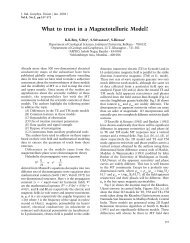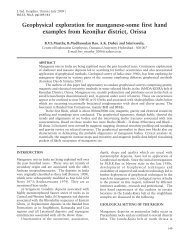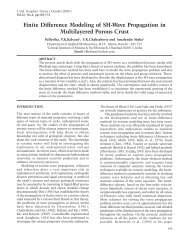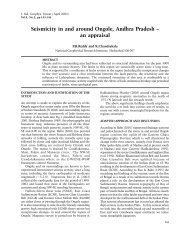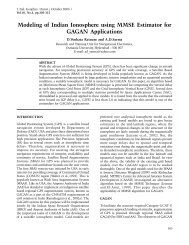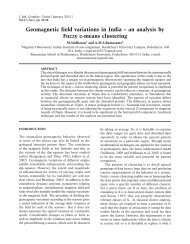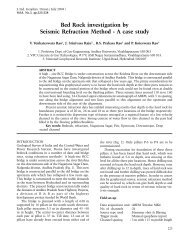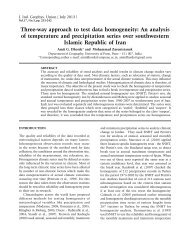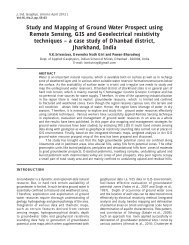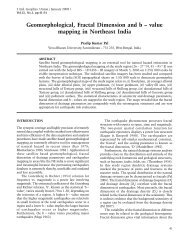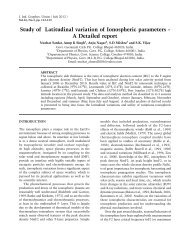U.S. De**, G. P. Singh* and D. M. Rase - IGU
U.S. De**, G. P. Singh* and D. M. Rase - IGU
U.S. De**, G. P. Singh* and D. M. Rase - IGU
You also want an ePaper? Increase the reach of your titles
YUMPU automatically turns print PDFs into web optimized ePapers that Google loves.
U.S. De, G. P. Singh <strong>and</strong> D. M. <strong>Rase</strong><br />
study analyses the last twenty years data pertaining<br />
to major floods in four metro cities of India, which<br />
have a population exceeding 5 million.<br />
DATA AND METHODOLOGY<br />
The first census of India during the 20 th century<br />
showed that only one city had a population more<br />
than one million. In 1991 census, 14 cities with<br />
population more than one million existed while<br />
the census of 2001 shows, 22 such cities. The four<br />
mega cities, which are under study, are located in<br />
the four quadrants of India, North - Delhi, East<br />
- Kolkata, West - Mumbai, <strong>and</strong> South - Chennai.<br />
Their population <strong>and</strong> population growth are taken as<br />
reported in Govt. of India census of 1991 <strong>and</strong> 2001<br />
(Table- 1). The major disasters caused due to floods in<br />
the four mega cities as reported in Disastrous Weather<br />
Events (DWE), (India Meteorological Department) are<br />
used in this study. In order to study urban flooding<br />
daily rainfall data for two observatories in each of the<br />
mega cities are used (1970-2006). For each mega city<br />
one observatory in the city <strong>and</strong> one in the airport<br />
are taken so that its spatial distribution of rainfall<br />
can be better analyzed. The stations are Colaba <strong>and</strong><br />
Santacruz Airport in Mumbai, Nungambakkam<br />
<strong>and</strong> Minambakkam Airport in Chennai, Alipur <strong>and</strong><br />
Dumdum Airport in Kolkata <strong>and</strong> Safdarjung <strong>and</strong><br />
Palam Airport in Delhi. Daily rainfall data for the<br />
period 1970-2006 have been utilized to study very<br />
heavy rainfall (≥125 mm) <strong>and</strong> phenomenal rainfall<br />
(≥150 mm) <strong>and</strong> their trends.<br />
FLOODS/HEAVY RAINS<br />
Floods occur in almost all the river basins of the<br />
country. A flood is an overflow of an expanse of water<br />
that submerges l<strong>and</strong>. Every year floods affect nearly<br />
400 million hectares of l<strong>and</strong> in India (Sinha Ray et<br />
al, 1999). Seasonal peak in mortality occurs during<br />
rainy season in the tropical belt. Specific cases of<br />
floods in the four metros of India are discussed in<br />
the next section.<br />
Urban Floods<br />
India is primarily an agricultural country. In the<br />
past, rural infra structure was adequate to sustain<br />
population of country. Migration of population<br />
towards mega cities has resulted in r<strong>and</strong>om expansion<br />
of urban sector. Such migrations are due to industrial<br />
growth. Presently some of the urban agglomerations<br />
accommodate more than 10 million people. According<br />
to a recent estimate, by 2015 India will have 34 cities<br />
in the population range of 1.5 million <strong>and</strong> above.<br />
Four mega Cities selected for the present study would<br />
have crossed 10 million mark, in which Mumbai<br />
would have the largest population density of more<br />
than 27 million. Majority of the poor live in informal<br />
settlements. In future these settlements would<br />
grow in a r<strong>and</strong>om way due to inadequacy of space<br />
<strong>and</strong> resources. Thous<strong>and</strong>s of illegal colonies have<br />
emerged in the mega cities resulting in constriction<br />
of natural drainage causing urban floods. Urban<br />
areas get flooding by different types of floods like<br />
river floods, flash floods, coastal floods, release of<br />
excess water from reservoir or failure of dam on the<br />
upstream side etc. Heavy rainfall is the main cause<br />
of urban flood. Due to intense <strong>and</strong> periodic rain,<br />
huge quantity of water flows, beyond the capacity<br />
of old drainage systems of the mega cities. Drainage<br />
system gets blocked due to silting, dumping of waste<br />
material at the inlets of drainage, encroachment over<br />
natural drainage <strong>and</strong> water bodies.<br />
Significant Urban Floods in India in recent years<br />
The Year 2005 was recorded as the hottest year of<br />
the century. Incidentally, in the same year the worst<br />
urban flooding was reported in Mumbai on 26/27 July,<br />
with the historical rainfall of 944 mm. In this year 10<br />
severe urban floodings, were also reported, in which<br />
Table 1. Population of four mega cities in India (MILLIONS)<br />
Megacities Census 1991(million) Census 2001 (million) Estimate growth(%)<br />
Mumbai 12.6 17.7 4.05%<br />
Kolkata 11.0 14.7 3.36%<br />
Delhi 8.4 13.8 6.43%<br />
Chennai 5.4 8.2 5.18%<br />
154



